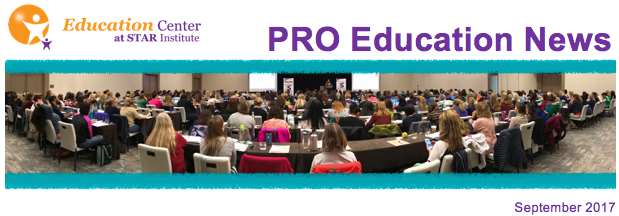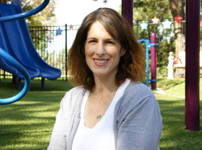
Developing Effective Family-Therapist Collaborations
By Mim Ochsenbein, MSW, OTR/L
 Some topics in the therapy world seem to come up again and again. There’s lots of reasons for that. Some just seem to be “buzzy” or “sexy” in any given year. Other times new research or a new treatment approach gets people’s attention. The more common reason? The issue, and the need around it, persists. Such is the case for looking at family-clinician collaboration. Family-clinician collaboration is a relevant topic across the lifespan for clients. But the partnership is particularly significant when looking at infants, children and youth. Fortunately, the conversation no longer focuses on why clinicians should make this a priority - the importance of a family’s role has been acknowledged. The conversation now revolves around how to work with families effectively. Clinicians and family members alike want to know how to be understood and how to be a part of the short and long-term solutions for the child.
Some topics in the therapy world seem to come up again and again. There’s lots of reasons for that. Some just seem to be “buzzy” or “sexy” in any given year. Other times new research or a new treatment approach gets people’s attention. The more common reason? The issue, and the need around it, persists. Such is the case for looking at family-clinician collaboration. Family-clinician collaboration is a relevant topic across the lifespan for clients. But the partnership is particularly significant when looking at infants, children and youth. Fortunately, the conversation no longer focuses on why clinicians should make this a priority - the importance of a family’s role has been acknowledged. The conversation now revolves around how to work with families effectively. Clinicians and family members alike want to know how to be understood and how to be a part of the short and long-term solutions for the child.
Being understood. Most caregivers can easily tell a therapist why they are seeking help. They can list the issues in the home and community. Or they can relay the issues shared with them by a teacher, coach, or physician. What they may have a harder time with is identifying what their goals are – what do they want things to look like when the therapy process is done? Sounds easy enough. But it’s not. When directly asked, many parents answer with “Not THIS!” Though valid, this demonstrates the family’s difficulty seeing what is possible. They can’t verbalize an answer because they can’t envision it. From the therapist’s perspective, this answer may cause them to feel overwhelmed. They do not have a good sense on where to start or what to address.
An easy way to bypass the issue is for a clinician to simply create the goals on their own, based on the stated problem and the findings of the therapist’s assessment. Simple enough. This approach creates goals that reflect a family’s input and will be within the therapist’s domain of practice, but it is not a truly family-centered approach and may not be the most accurate measure of gains. Without the family being able to “see” what life could be like, the therapist has lost the family’s buy-in to the true potential of the therapy. They may be supportive of the goals the therapist crafted, but they are already a step removed from the commitment and drive created when they directly collaborate on a goal that they actually saw in their mind’s eye.
Think about it. When are we most motivated? When the aim is something personal, something we can see happening (saving money for the car you can see yourself driving, pulling an all-nighter to get the grade you have to have). That’s the state a therapist wants their client-family to be in – motivated, committed, invested. It’s the state the family wants their therapist to be in as well! Goals that clearly reflect the family’s desires and the realistic capabilities of therapy through a collaborative effort is the easiest way to get there.
There are strategies therapists can use to help guide families in this collaborative process. Once the larger issue has been identified (through family stated concerns and clinical assessment), the clinician helps the family isolate a specific activity that is regularly impacted. The therapist facilitates discussion about when the impact is most acutely felt. For example, the family may have identified the larger issue as poor attention to task. The therapist asks when they see this at home - this helps the family to start to narrow things down. Perhaps the parents quickly identify the morning routine as problematic, requiring multiple cues and a lot of time. Knowing the specific parts of the routine, how long these parts take, and other supporting details allows a clearer picture to form for both the therapist and the family. Drilling down to the details of the routine may require the clinician to facilitate with guiding questions. The more detailed, the better. It is easier for both the parent and the therapist to “see” what is happening. Then the therapist can help the family determine what the morning could look like as therapy addresses the underlying issues. What is desirable? What is realistic? What would that look like? Now a parent is actually seeing the possibilities as it applies to their personal experience. Now the therapist knows exactly what the expectation is from the therapy. The therapist and the family are therapeutically aligned. This may not be a short conversation, but its impact will be felt throughout the therapeutic program.
Being part of the solution. Creating therapeutic alliance through joint goal development is an excellent first step towards family-clinician collaboration. But the rest of the journey can’t be ignored. Collaboration requires participation. Caregivers should be in therapy sessions regularly (preferably always). By being an active participant in the session, caregivers have the chance to experience the successes of the session first-hand, model the therapist’s techniques in real-time, and increase their understanding of their child’s specific needs and strengths. The therapist gains invaluable insight into the parent and child dynamic, a chance to tailor strategies in actual time, and the ability to educate while providing intervention. Parent and therapist (and child) benefit from the full attention of the other for the session and the rapport that is built from these sessions.
The prospect of having the parent in the room, much less actively participating in the session, can be anxiety-provoking for both the therapist and parent. Typically, the root causes of the discomfort for both are the same. Neither wants to feel judged. Neither wants to feel they don’t know what they are doing. Neither wants to feel that the therapy isn’t working. Being able to recognize what is causing the anxiety and addressing it is key. For the therapist, that means addressing not only their own needs, but that of the parent. Clear goals, roles and expectations made at the start of the therapeutic process can help. Pressure is relieved if everyone knows what they are working on, why, and desired outcomes of each session.
Clinicians need to communicate what the role of a parent is during the session and the focus of the session. Does the therapist want the parent to ask questions during the session? To wait until after? Will the therapist be acting more as a coach for the parent, or will the therapist be the lead? These are the things the clinician will want to have figured out and communicated to the parent prior to the session. The parent’s responsibility is to be a willing and engaged participant in the process. If the therapist and parent can achieve this, they will be rewarded with richer, more powerful therapy sessions. That leads to improved carry-over outside the therapy sessions and improved outcomes of the therapy process. And that’s the whole point, right?
Developing strong, effective family-therapist collaborations is not easy and does not happen overnight. There are resources out there to help. STAR Institute has an online catalog of videos available to the public through SPD University. Each of the experts discussed here offers a unique component to the complex process of clinician-family collaboration. Dr. Lucy Jane Miller talks about this very process and how to apply it in practice in course 3233: Working with Families: Implementing A SECRET in Clinical Practice. Amy Laurent also presents on the collaboration between professionals and families in her course 3230: Enhancing Communication and Social-Emotional Abilities in Children with Autism Spectrum Disorder: Engaging Family-Professional Partnerships. Rosemary White’s course, 3235: Strategies for Arousal Regulation, highlights the importance of understanding the “individual profile” of the child and the caregiver to support arousal regulation. Each of these experts provides a unique component to the complex process of clinician-family collaboration.
NEW Online Courses
3233: Working with Families: Implementing A SECRET in Clinical Practice
Reviews the framework, A SECRET developed by Dr. Lucy Jane Miller, OTR and highlighted in the book No Longer A SECRET: Unique and Common-Sense Strategies for Children with Sensory and Motor Challenges (Bialer & Miller, 2011).
More details
3230: Enhancing Communication and Social-Emotional Abilities in Children with Autism Spectrum Disorder: Engaging Family-Professional Partnerships.
An introduction of regulatory challenges and social communicative difficulties experienced by individuals diagnosed with ASD, followed by practical guidelines for prioritizing learning objectives in these areas for a wide range of developmental functioning.
More details
3235: Strategies for Arousal Regulation
Highlights the importance of understanding the “individual profile” of the child and the caregiver to support arousal regulation. Emphasis on putting the “relationship” in the forefront and “tailoring interactions” to support sensory and emotional regulation moment to moment.
More details
2017 AOTA Pre-Conference Institute: Translation of Assessment Finding to Treatment: How Occupational Performance is impacted by Underlying Sensory and Motor Abilities
Dr. Lucy J. Miller and STAR Faculty present advances in assessment and treatment for children with ASD and SPD. Sensory-related assessment findings are linked to occupational performance using the Sensory Processing: 3 Dimensions test. Test findings are translated into effective occupation-based treatment using the STAR Treatment Model.
More details
NEW In-person Programs
Pre-Symposium Parent Workshop
October 5, 2017 • Greenwood Village, CO
STAR Institute continues its very successful Pre-Symposium Parent Workshop series with this year’s theme, “Relationships and SPD Across the Lifespan.” Parents will hear presentations from a panel of local and national experts, each focusing on a particular age group ranging from zero to adulthood, followed by participation in small group discussions.
More details
20th International 3S Symposium
October 6-7, 2017 • Denver, CO
A one of a kind opportunity to learn the latest from the greatest in the field of SPD. Choose from presentations on both the Research Track and the Strategies Track. Network with other dedicated parents and professionals.
More details
Off-site Level 1 Mentorship Program
This 4-day version of the onsite Level 1 Mentorship program offers the same core content as the onsite program at STAR Institute. An opportunity to learn to apply clinical reasoning through lectures, video treatment observation and analysis with two experienced STAR faculty.
More details
Mental Health Mentorship Program
A 3-day course where mental health providers develop a sensory processing lens to view behaviors associated with presenting mental health concerns. Develop critical thinking pathways for SPD recognition and a toolbox of assessment strategies and resources to use in practice for evaluation, referral and education.
More details
